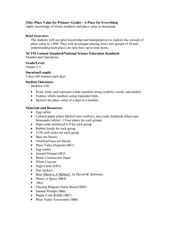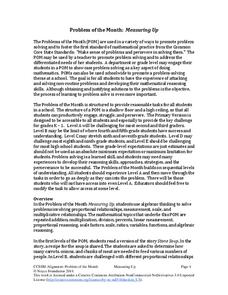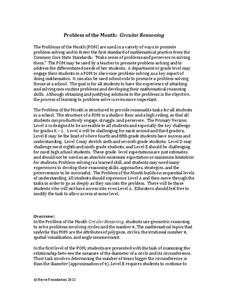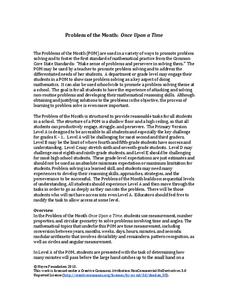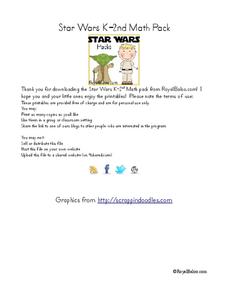Curated OER
All About Money
Few topics engage young mathematicians as much as learning about money. Through a series of shared readings and hands-on activities, children explore the US currency system, learning how to count money and calculate change as they create...
CoreCommonStandards.com
Common Core State Standards: Second Grade Workbook
You've hit the second grade Common Core jackpot! Find over 40 pages of curriculum designed specifically for the standards, both math and language arts. Printable versions of each standard can be used as learning displays, and...
Scholastic
Study Jams! + and - Without Regrouping
Addition and subtraction are essential skills for all young mathematicians. Explain the step-by-step process with respect to place value using these real-world examples. Focus is on numbers in the tens, hundreds, and thousands, making...
Oklahoma State University
A Hundred Bales of Hay
This lesson combines math, visual arts, and language arts activities that all focus on the making, and baling of hay. The activities can be adjusted to address different age ranges. Most of the activities focus on gaining...
DK Publishing
Tricky Word Problems - Choosing the Operation
Decipher the equations in these addition and subtraction word problems. Two examples at the top of the page guide second graders as they solve the rest of the problems. There is no space to write out the equation, but there is a place to...
DK Publishing
Tricky Word Problems, Part 2 - Choosing the Operation
Can your learners figure out which equation to solve? Use this resource to challenge your third graders with word problems involving the four operations. Each problem has a section to write the answer, but pupils will need to write out...
Scholastic
Math Word Problems
After reading The Mitten by Jan Brett, youngsters willuse the characters in the story to write word problems for addition and subtraction. For example, they may state that a rabbit had 7 carrots and then lost 2, how many were left? There...
National Security Agency
Place Value for Primary Grades- A Place for Everything
Here is a phenomenal lesson on place value to the thousands place. Learners construct numbers and identify the value of each digit, investigate building numbers using craft sticks and paper plates, and complete other meaningful...
Arcademics
Skateboard Pups
Players skate their way to the finish line by adding and subtracting two-step expressions as fast as possible.
Purdue University
Food Waste Solutions
Easy doesn't always mean better. In an era with pre-packaged everything, learners consider the environmental impact of the convenient trend. They critique the packaging of food and how waste impacts cost and then look for solutions.
ABCya
Christmas Lights Math
Get into the holiday spirit with math! As learners complete addition, subtraction, multiplication, or division problems, they earn Christmas lights that they can then use to decorate a virtual house.
ABCya
Gobble Squabble
A Thanksgiving-themed interactive boosts addition, subtraction, multiplication, and division facts. Using the keyboard's arrows, players navigate a turkey through a maze, gobbling up as many berries as possible without getting tagged by...
Curriculum Corner
Sports of All Sorts
Do your students love sports? Do they love math and reading? If the first answer is yes and the second is no, a resource with sports-themed math and literacy games may change their minds! Learners move through stations to practice...
Illustrative Mathematics
Saving Money 2
Adding money is a key skill in life. Give a activity that requires second graders to find the total amount of money Louis needs to make certain school supply purchases.
Noyce Foundation
Perfect Pair
What makes number pairs perfect? The resource provides five problems regarding perfect pairs of numbers, the definition of which changes in complexity with each task. Solutions require pupils to apply number sense and operations, as well...
Noyce Foundation
Diminishing Return
Challenge individuals to compete as many tasks as possible. Lower-level tasks have pupils apply costs and rates to solve problems. Upper-level tasks add algebraic reasoning and conditional probability to the tasks.
Noyce Foundation
Double Down
Double the dog ears, double the fun. Five problems provide increasing challenges with non-linear growth. Topics include dog ears, family trees and population data, and geometric patterns.
Noyce Foundation
Measuring Up
Teach the basics of measurement and conversion with a five-lesson resource that builds an understanding of proportion and measurement conversion from elementary through high school. Initially, young scholars use ratios to determine soup...
Noyce Foundation
Circular Reasoning
Examine the origin and application of pi in five different levels. The five lessons in the resource begin with an analysis of the relationship between the radius and circumference of a circle. The following lessons lead learners through...
Noyce Foundation
Once Upon a Time
Examine the relationship between time and geometry. A series of five lessons provides a grade-appropriate problem from elementary through high school. Each problem asks learners to compare the movement of the hands on a clock to an angle...
Noyce Foundation
Tri-Triangles
Develop an understanding of algebraic sequences through an exploration of patterns. Five leveled problems target grade levels from elementary through high school. Each problem asks young mathematicians to recognize a geometric pattern....
Noyce Foundation
Miles of Tiles
Create number sentences and equations to solve geometric problems. Each activity in the series of five asks young mathematicians to consider different-sized tiles to build structures according to specific criteria. The first activities,...
Royal Baloo
Star Wars K-2nd Math Pack
Included in a Star Wars themed packet, young padawans enhance mathematical skills such as graphing, computing using basic operations, counting numbers and money, telling time, and measuring. Scholars play a game of sudoku, read...
Suffolk Public Schools
Solving Word Problems
Lower young mathematicians' affective filter with a problem solving presentation that details four steps to make word problems appear less daunting.









